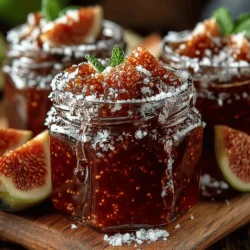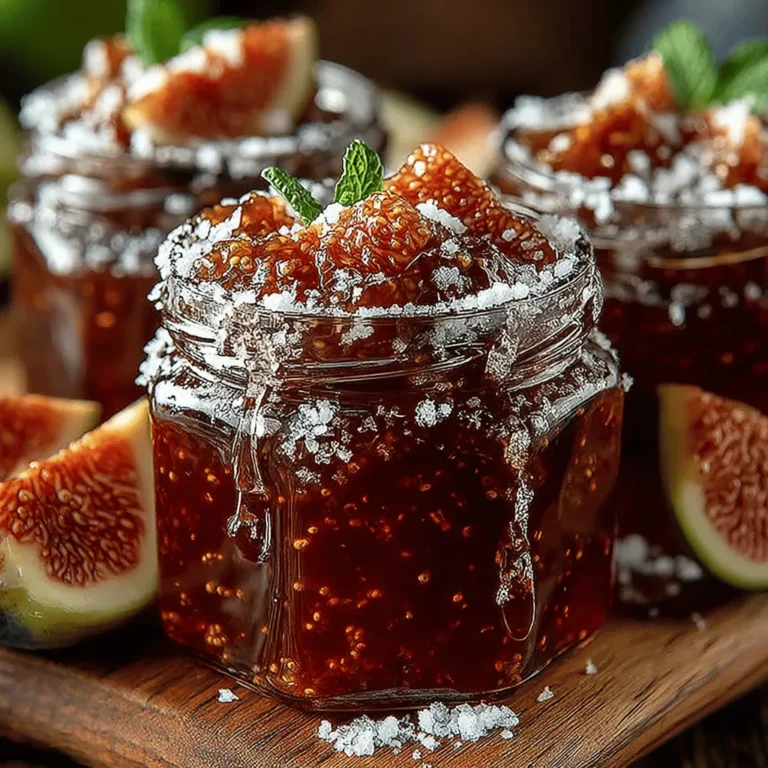Introduction
Welcome to the delightful world of homemade preserves, where flavor meets tradition in the form of Rustic Slow Cooker Fig Jam. This recipe is not just about creating a sweet spread; it’s about savoring the unique essence of fresh figs throughout the year. Fig jam is a versatile addition to your breakfast table, elevating everything from toast to cheese boards with its rich, fruity flavor. By utilizing a slow cooker, you can simplify the jam-making process, allowing the figs to break down slowly and develop a depth of flavor without the need for constant stirring or monitoring.
In this article, we will walk you through each step of the Rustic Slow Cooker Fig Jam recipe while shedding light on the health benefits of figs, their historical significance, and tips to enhance your culinary experience. Whether you are a seasoned jam maker or trying your hand at preserves for the first time, this guide will equip you with the knowledge needed to create a delicious batch of fig jam that is sure to impress.
Understanding the Appeal of Fig Jam
Exploring the History of Fig Jam
Figs have long been revered as a fruit of significance across various cultures and historical periods. Originating from the Mediterranean region, figs have been cultivated for thousands of years, with records dating back to ancient civilizations. The ancient Greeks and Romans celebrated figs not only for their delicious taste but also for their nutritional benefits. Fig jam has roots in many cuisines around the world, from the sweet spreads of Mediterranean countries to the traditional preserves found in Middle Eastern cultures.
The process of making jam has evolved over centuries, with figs often being transformed into preserves as a way to prolong their shelf life and capture their sweet essence. In many cultures, fig jam is enjoyed with bread, cheese, and meats, highlighting its versatility as both a sweet and savory accompaniment. This historical significance adds a layer of appreciation to the process of making fig jam at home, connecting us to culinary traditions that have stood the test of time.
Health Benefits of Figs
Beyond their rich history and cultural importance, figs are a powerhouse of nutrition, making them an excellent choice for a guilt-free treat. Fresh figs are packed with dietary fiber, which aids in digestion and promotes gut health. Their high antioxidant content helps combat oxidative stress in the body, while vitamins such as A, B, and K contribute to overall well-being.
Incorporating fig jam into your diet can provide a sweet indulgence without sacrificing health. The natural sugars found in figs are complemented by their fiber content, making them a more balanced option compared to other sugary spreads. Whether spread on toast, drizzled over yogurt, or used as a filling in pastries, fig jam allows you to savor the health benefits of this remarkable fruit while enjoying its delectable flavor.
Ingredients Breakdown
Fresh Figs: The Star Ingredient
At the heart of this Rustic Slow Cooker Fig Jam recipe lies the fresh fig, a fruit that is as beautiful as it is delicious. Characterized by its unique texture—soft yet slightly chewy—and its naturally sweet flavor, fresh figs are a true culinary gem. When selecting figs for your jam, look for those that are plump, tender, and free from blemishes. The ideal figs should feel slightly soft to the touch, indicating ripeness.
Quality is key in jam-making, so opt for organic figs whenever possible to ensure you are using fruit that is free from pesticides and additives. Additionally, consider purchasing figs that are in season, as they will offer the best flavor and sweetness. Depending on your location, figs are typically in season from late summer to early fall, making this the perfect time to experiment with making fig jam.
Sweeteners and Flavor Enhancers
While fresh figs are naturally sweet, incorporating granulated sugar into your fig jam recipe serves several important purposes. Sugar acts as a preservative, helping to inhibit the growth of bacteria and mold, ensuring your jam remains fresh for longer. It also balances the flavors of the figs, enhancing their natural sweetness while adding a smooth texture to the final product.
For those looking for healthier alternatives, consider using natural sweeteners such as honey or agave syrup. These options can impart their unique flavors to the jam while still providing the necessary sweetness. Keep in mind that if you choose to use honey, it may slightly alter the consistency and taste of the jam, so adjust the quantity according to your preference.
The Importance of Lemon Juice
One of the essential ingredients in this Rustic Slow Cooker Fig Jam recipe is fresh lemon juice. Not only does lemon juice add a bright, zesty flavor that complements the sweetness of the figs, but it also plays a crucial role in the preservation process. The acidity in lemon juice helps to balance the natural sugars of the figs, ensuring a well-rounded taste.
Moreover, the citric acid found in lemon juice acts as a natural preservative, extending the shelf life of your jam. When making fig jam, it is important to use freshly squeezed lemon juice for the best flavor. Bottled lemon juice often contains preservatives that can affect the overall taste of the jam, so opt for the real thing whenever possible.
Step-by-Step Recipe Instructions
Preparing the Figs
Now that we have a solid understanding of the ingredients and their roles in our Rustic Slow Cooker Fig Jam, it’s time to dive into the initial steps of the recipe. The first stage in creating your fig jam begins with preparing the figs.
1. Washing and Cleaning: Start by gently rinsing your fresh figs under cool running water. This will remove any dirt or impurities that may be on the surface. After washing, pat them dry with a clean kitchen towel.
2. Removing Stems: Using a sharp knife, carefully remove the stems from each fig. This step is crucial, as the stems can be tough and may impact the texture of your jam.
3. Chopping the Figs: Depending on the size of your figs, you can either leave them whole or cut them into quarters. If using larger figs, chopping them into smaller pieces will help them break down more easily during the cooking process.
4. Combining Ingredients: Once your figs are prepared, it’s time to combine them with the other ingredients. In a large bowl, mix the chopped figs with the granulated sugar, freshly squeezed lemon juice, and any additional flavor enhancers you may wish to incorporate, such as vanilla extract or spices like cinnamon or nutmeg. Allow the mixture to sit for about 15-30 minutes. This resting period will help draw out the natural juices from the figs, creating a syrupy base for your jam.
With the figs prepped and combined with the sweeteners and lemon juice, you’re ready to move on to the next steps of the recipe, which will involve transferring the mixture to your slow cooker and letting the magic happen. But before we get to that, let’s take a moment to appreciate the beauty of this process and the anticipation of creating something truly special in your kitchen.
{{image_2}}
Preparing Fresh Figs: Washing, Stemming, and Quartering
To begin our journey towards creating delicious rustic slow cooker fig jam, the first step involves preparing fresh figs. Selecting ripe figs is crucial; they should feel soft to the touch and possess a sweet aroma. Once you’ve gathered your figs, follow these steps to ensure they are clean and ready for cooking:
1. Washing: Rinse the figs gently under cold running water. Avoid using any soap or cleaning agents as they can leave unwanted residues. Use your fingers to rub off any dirt or debris. After rinsing, pat them dry with a clean kitchen towel.
2. Stemming: Use a sharp knife or kitchen scissors to remove the stems from each fig. This step is essential as the stems can impart a bitter flavor to your jam. Simply cut the stem off at the base, ensuring you do not cut too deeply into the fruit.
3. Quartering: Once your figs are washed and stemmed, it’s time to quarter them. Place the figs on a cutting board and slice each fig into quarters. This can be done by cutting them in half lengthwise and then cutting each half into two pieces. Quartering the figs not only helps them to break down more easily during cooking but also allows for a more even distribution of flavors.
By carefully preparing your figs, you ensure a rich foundation for your fig jam, allowing the natural sweetness and flavor to shine through in your final product.
Combining Ingredients for Maximum Flavor
The next step in crafting your fig jam involves combining the prepared figs with other key ingredients: sugar, lemon juice, vanilla extract, and spices. This mixture not only enhances the flavor of the figs but also plays a vital role in the preservation of the jam. Here’s how to achieve the best flavor infusion:
1. Mixing the Ingredients: In a large mixing bowl, combine your quartered figs with sugar. The sugar helps to draw out moisture from the figs, which is essential for creating a jam-like consistency. It’s advisable to use a ratio of about 1:1 for figs and sugar, but you can adjust based on your sweetness preference.
2. Adding Acidity: Next, squeeze fresh lemon juice into the mixture. The acidity from the lemon juice not only balances the sweetness but also acts as a natural preservative. For about 2 pounds of figs, 2 tablespoons of lemon juice should suffice.
3. Incorporating Flavor: Add a splash of vanilla extract for depth and warmth, along with any spices you wish to use. A pinch of cinnamon or nutmeg can add a delightful complexity to your fig jam, enhancing its rustic charm.
4. Tossing Everything Together: Gently toss the ingredients until the figs are well-coated with sugar and the other components. This step is crucial as it allows the sugar to start dissolving and encourages the figs to release their juices, creating a syrupy base for the jam.
By thoroughly mixing these ingredients, you set the stage for a deliciously balanced fig jam that bursts with flavor.
Slow Cooking for Perfect Consistency
Once your figs and other ingredients are mixed, it’s time to transfer everything into your slow cooker. The slow cooking process is paramount for achieving the rich, concentrated flavor and ideal consistency of fig jam.
1. Setting Up Your Slow Cooker: Pour the fig mixture into the slow cooker, spreading it evenly across the bottom. Set the slow cooker to low heat. Cooking on low allows for a gentle simmer, which helps the figs break down slowly and meld with the sugar and spices.
2. Cooking Time: Allow the figs to cook for 6 to 8 hours. This slow cooking method enables the flavors to blend beautifully, creating a luscious jam that captures the essence of fresh figs.
3. Stirring Occasionally: Every couple of hours, stir the mixture gently to ensure even cooking and prevent any sticking to the edges of the cooker. This is also a good time to monitor the aroma filling your kitchen – a sweet, fruity scent will indicate that your fig jam is well on its way.
Slow cooking not only simplifies the process but also helps to develop a deep, complex flavor profile that is difficult to achieve with more rapid cooking methods.
Monitoring and Adjusting Consistency
As your fig jam cooks, it is important to monitor its consistency. Achieving the right texture can be a delicate balance, so here are a few techniques to ensure your jam reaches the perfect spreadable state:
1. Checking Consistency: After about 6 hours of cooking, check the jam’s consistency. Dip a spoon into the mixture and allow a few drops to fall back into the cooker. If the drops hold together and don’t run too quickly, you’re on the right track.
2. Mashing or Blending: If the jam still appears chunky, you may wish to mash it slightly with a potato masher or blend it with an immersion blender for a smoother texture. This step is optional, depending on your preference for chunkiness in your jam.
3. Final Cooking Time: If the jam is too thin, continue cooking it on low and monitor closely, stirring occasionally. If it needs a bit more time, increase the heat to medium for the last hour. The moisture should evaporate, thickening the jam to your desired consistency.
By carefully monitoring and adjusting the consistency of your fig jam, you can create a spread that is perfectly suited to your taste.
Jarring and Storing the Jam
Once your rustic fig jam has reached the desired consistency, it’s time to jar and store it safely. Proper jarring techniques are essential to ensure your jam remains fresh and delicious for as long as possible.
1. Sterilizing Jars: Start by sterilizing your jars and lids. You can do this by placing them in boiling water for 10 minutes or running them through a hot cycle in your dishwasher. Ensure they are completely dry before filling them with jam.
2. Filling the Jars: Using a ladle, carefully spoon the hot fig jam into the sterilized jars, leaving about 1/4 inch of headspace at the top. This space is important as it allows for the expansion of the jam during cooling.
3. Sealing: Wipe the rims of the jars with a clean cloth to remove any residue. Place the lids on and screw on the bands until they are fingertip-tight. Do not overtighten, as this can prevent a proper seal.
4. Cooling and Storage: Allow the jars to cool completely at room temperature. Once cooled, check the seals by pressing down in the center of each lid. If it doesn’t pop back, the jar is sealed properly. Store sealed jars in a cool, dark place for up to one year. For opened jars, refrigerate and consume within a few weeks.
By following these steps, you can ensure that your homemade fig jam is preserved safely and will retain its delightful flavor for many months.
Creative Ways to Serve Fig Jam
With your rustic slow cooker fig jam ready, it’s time to explore the many ways to enjoy this delectable spread. Fig jam is not only versatile but adds a touch of sophistication to various dishes.
1. Breakfast Spreads: Slather fig jam on your morning toast, bagels, or English muffins for a sweet start to your day. It pairs wonderfully with cream cheese or ricotta for a delightful contrast.
2. Cheese Pairings: Fig jam is a perfect accompaniment to cheese. Serve it with a cheese platter featuring creamy brie, tangy goat cheese, or sharp cheddar. The sweetness of the jam balances the saltiness of the cheese beautifully.
3. Dessert Toppings: Use fig jam as a topping for desserts like cheesecake, panna cotta, or ice cream. Its rich flavor can elevate simple desserts, creating an indulgent treat.
4. Charcuterie Boards: Add fig jam to your charcuterie board alongside cured meats, olives, and nuts. This combination offers a delightful array of flavors and textures, making it a hit at gatherings.
Gift-Worthy Presentation
Homemade fig jam makes for a thoughtful and personal gift. Here are some ideas to present your fig jam beautifully:
1. Decorative Jars: Consider using mason jars and decorating them with fabric or twine around the lid. You can also attach a handwritten label with the name of the jam and the date it was made.
2. Recipe Cards: Include a small recipe card with serving suggestions or a simple recipe that incorporates the fig jam. This adds a personal touch and shows recipients how to enjoy your creation.
3. Gift Baskets: Create a themed gift basket that includes your fig jam, artisanal bread, a selection of cheeses, and perhaps a bottle of wine. This makes for a delightful gift for food lovers.
By presenting your homemade fig jam in an appealing way, you not only share a delicious treat but also spread joy through the effort and creativity you put into it.
Conclusion
Homemade rustic slow cooker fig jam is a versatile and flavorful addition to your culinary repertoire. By following this simple recipe, you can enjoy the unique taste of figs in a delightful spread that enhances many dishes. Whether you’re enjoying it on your morning toast, sharing it with friends, or presenting it as a thoughtful gift, this fig jam embodies the joy of homemade goodness. Embrace the art of preserving, and let the flavors of your kitchen tell a delicious story.


